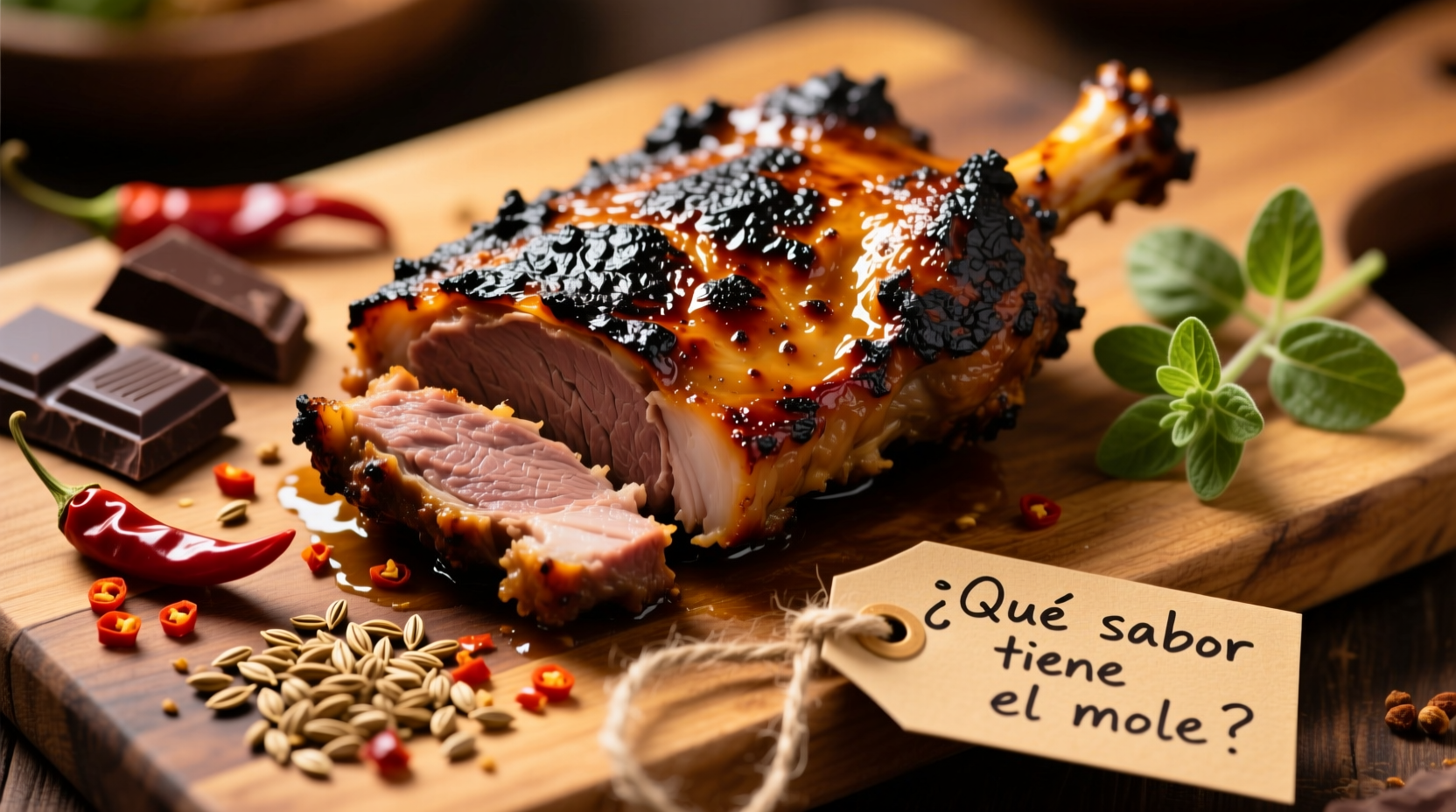When you first taste authentic Mexican mole, you're experiencing one of the world's most sophisticated flavor compositions. This isn't your ordinary sauce—it's a culinary masterpiece that represents centuries of cultural fusion. Forget everything you think you know about chocolate in savory dishes; mole's complexity defies simple description.
The Essential Flavor Profile: What You Actually Taste
When a spoonful of properly prepared mole touches your tongue, you'll experience a carefully orchestrated progression of flavors:
- Initial impression: A subtle sweetness from plantains or tomatoes, followed by earthy notes from toasted spices
- Middle notes: The warmth of multiple chilies (ancho, mulato, pasilla) creating layered heat—not overwhelming but present
- Base notes: Deep, roasted undertones from sesame seeds, nuts, and spices like cumin and cloves
- Finishing touch: That distinctive chocolate element (from Mexican tablet chocolate, not cocoa powder) that adds richness without sweetness
Unlike Western interpretations that overemphasize the chocolate component, authentic mole achieves perfect balance where no single flavor dominates. The texture is equally important—smooth, velvety, and substantial enough to coat chicken or turkey without being heavy.

Understanding Mole's Complexity: The "Why" Behind the Taste
Mole's distinctive flavor profile developed through centuries of cultural exchange. The sauce represents a true mestizaje (mixing) of indigenous Mesoamerican and Spanish culinary traditions. Pre-Hispanic civilizations used complex sauces made from chilies, seeds, and spices; Spanish colonizers introduced European ingredients like chocolate, almonds, and cinnamon.
| Historical Period | Key Ingredients Added | Flavor Impact |
|---|---|---|
| Pre-Hispanic (Before 1521) | Chilies, tomatoes, tomatillos, seeds | Created foundational earthy, spicy base |
| Colonial Period (1521-1821) | Chocolate, spices, nuts, bread | Added complexity, sweetness, and thickening elements |
| Modern Era (1821-Present) | Refined techniques, regional variations | Development of distinct regional mole styles |
According to research from Mexico's National Institute of Anthropology and History, the most authentic moles contain between 20-30 ingredients, each contributing specific flavor elements that create the sauce's signature complexity. The careful toasting and grinding process transforms these individual components into something entirely new.
How to Experience Mole Like a Connoisseur
Understanding mole's flavor requires knowing what to look for during the tasting experience:
- Observe the color: Authentic mole negro should be deep, almost black, with reddish undertones—not brown like a typical gravy
- Smell before tasting: You should detect multiple aromatic layers—not just chocolate, but toasted spices, chilies, and subtle fruit notes
- First taste: Notice how the flavors develop—sweetness first, then spice, then the deeper chocolate notes
- Mouthfeel: It should coat your palate smoothly without being greasy or heavy
When properly prepared, mole should never taste predominantly of chocolate. As Maya Salcedo, culinary historian at Mexico City's Escuela de Gastronomía Mexicana explains: "The chocolate in mole functions as a thickening agent and flavor enhancer, not as the primary flavor. When chocolate dominates, you're tasting a simplified version that misses mole's true complexity. Authentic mole achieves balance where chocolate is just one supporting player among many."
Mole vs. Other Sauces: Setting the Record Straight
Many people mistakenly compare mole to American-style chocolate sauces or even teriyaki. Here's how mole differs from similar preparations:
- Mole vs. Chocolate Sauce: Chocolate sauce is sweet and dessert-oriented; mole uses chocolate as just one element in a savory profile
- Mole vs. Adobo: Adobo relies primarily on vinegar and chilies; mole incorporates multiple flavor dimensions including sweet, bitter, and umami
- Mole vs. Curry: While both are complex spice blends, mole features distinctive Mexican ingredients like hoja santa and specific chili varieties not found in curry
The confusion often stems from oversimplified restaurant versions that emphasize the chocolate element for unfamiliar palates. Traditional Oaxacan mole negro, for example, contains over 25 ingredients including multiple chili varieties, spices, nuts, seeds, and just enough chocolate to add depth without sweetness.
Navigating Mole Variations: What to Expect
Understanding that "mole" refers to a family of sauces—not a single recipe—is crucial for setting proper taste expectations. The most common varieties include:
- Mole Negro (Oaxaca): The most complex version with deep, smoky flavors and subtle chocolate notes
- Mole Rojo (Puebla): Brighter, more tomato-forward with noticeable but balanced heat
- Mole Coloradito: Sweeter profile with pronounced tomato and ancho chili flavors
- Mole Verde: Herbaceous and fresh, featuring pumpkin seeds and green herbs rather than chocolate
When sampling mole outside Mexico, be aware that ingredient substitutions often alter the flavor profile significantly. Many American versions use cocoa powder instead of authentic Mexican chocolate, which lacks the cinnamon and sugar traditionally included in tablet chocolate. Others reduce the number of chili varieties for simplicity, resulting in a one-dimensional heat rather than mole's characteristic layered warmth.
According to a 2023 study published in the Journal of Ethnic Foods, authentic mole preparation requires specific techniques that significantly impact flavor development. The study found that properly toasted and ground spices released 37% more aromatic compounds than pre-ground alternatives, explaining why homemade mole tastes dramatically different from simplified versions.
Common Misconceptions About Mole's Flavor
Several persistent myths distort people's expectations of mole:
- "Mole is just chocolate sauce": Chocolate is just one component among dozens, and in authentic preparations, it's not the dominant flavor
- "All mole is extremely spicy": Traditional mole features complex heat that builds gradually, not overwhelming spiciness
- "Mole tastes like mole (the animal)": The name comes from the Nahuatl word "mōlli," meaning sauce or concoction—not the burrowing mammal
- "Mole is difficult to make": While complex, the technique is straightforward with proper guidance—many ingredients are simply toasted and blended
Understanding these distinctions helps set proper expectations for experiencing authentic mole. When prepared correctly, mole offers one of the most sophisticated flavor experiences in global cuisine—a true testament to Mexico's rich culinary heritage.











 浙公网安备
33010002000092号
浙公网安备
33010002000092号 浙B2-20120091-4
浙B2-20120091-4